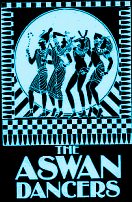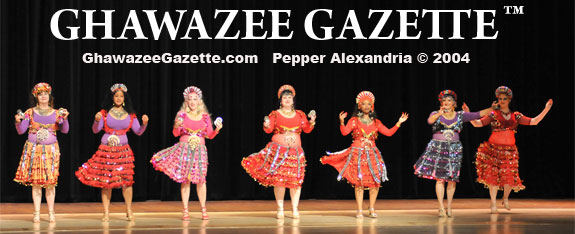GHAWAZI
Carnival of Stars Belly Dance Queen
Postcard from Edwina Nearing
July, 1983
Dear Amina,
Well, don't believe anything I say. After writing you why I shouldn't work with the Banat Mazen, I turned right around and went back to Luxor and worked with them a few weeks. It was as hard as I thought it would be, but I'm glad I did it - I learned a lot. They sort of expect me back for the whole season next year -- it's nice to know I have a job somewhere if I want it!
Eddy
===========================================================================
July, 2012
TOUR LUXOR FOR A NICKEL
The Qur'an's
injunction to women to "cover their ornaments" means that a
YouTube stroll down Cairo's smoggy, traffic-clogged streets these days
will usually reveal a number of women whose attire gives a new twist to
the expression "bag ladies." As the female half of the
city's population tries to reconcile their society's demands that they
be both attractive and unattractive, male testosterone, poverty and political
gridlock escalate and Cairo rumbles with discontent, occasionally erupting
into riots and lethal gunfire.
But escape to the world
of ancient temples, Pharaonic splendor and dancing girls is still possible.
Give your Cairo hotel's concierge, or a friendly bell-hop or waiter in
the hotel restaurant a little baksheesh
(a tip), and US$10 or $15 to buy a second-class ticket for the 12-hour
train trip to Luxor, and kiss stressful Cairo good-bye!
Luxor is a small town in
Egypt's deep south, still showing many of the characteristics of the quiet
little village it was 25 years ago. Its people are a mixture of
Sunni Muslims and Coptic Christians, and include faces as near to those
of the ancient Egyptians as one is likely to find anywhere in Egypt.
And not surprising, for the vast ruins of the Temple of Luxor less than a mile from the train station are only one of the great monuments in the area -- the Colossi of Memnon, the Temple of Karnak, the Tomb of King Tutankhamun -- that bear witness to Luxor's reign as the capitol of ancient Egypt for more than a thousand years. Cairo has the Pyramids and the Sphinx, but little else remaining from three milennia of Pharaonic rule; even the marble facing of the Pyramids has been stripped off by Cairo's many conquerors to be reused in other building projects. But the Valley of the Tombs of the Kings across the Nile River that bounds Luxor, accessible by ferry boats that leave the river's banks in Luxor every few minutes for less than a dollar, still hides treasures that lure archaeologists, and the mild, sunny winter climate that tempted many visitors to Egypt to spend months in Luxor in the more leisurely Victorian era still tempts the modern traveler to stay an extra day -- and another, and another . . .
Luxor and its environs
are home not only to the greatest concentration of memorials to Egypt's
Pharaonic past, but to many other fascinating cultural vestiges that have
disappeared in Cairo.. Luxor and the nearby provincial capital of
Qena were long a favorite refuge for out-of-favor Turkish and Mamlouk
pashas from Cairo, and for the perennially out-of-favor Ghawazi dancing
girls, many of whom were ethnic Gypsies. Lady Duff Gordon, a highly
literate Victorian-era Englishwoman who chose to spend the last years
of her life in Luxor, wrote of the Ghawazi: "I never quite
know whether it is now or four thousand years ago, or even ten thousand,
when I am in the dreamy intoxication of a real Egyptian fantasia; nothing
is so antique as the Ghawazi -- the real dancing girls." At
least two Ghawazi, Khairiyya and Raja' Mazin, Dom Nawar Gypsies, can still
be found in Luxor..
Not only Gypsies and Turkish
noblemen, but bedouin: Nag' Hamadi, also near Luxor, was the terminus
of a popular migration route of nomadic Arab bedouin from the Red Sea
coast and Arabia. Sections of tribes, like Cairo's pashas, sometimes
found it expedient to take this route and settle permanently around Luxor.
Even now the sharp-eyed visitor can spot a few bedouin along the old route
to Nag' Hamadi, and certain quarters of towns and villages around Luxor
"belong" to the tribal sections who settled there in the past
and are still proud to call themselves "Arabs."
And it seems as if half
the population of the area clamors to carry your luggage and take you
to the "best cheap" hotel in town as soon as you get off the
train when you arrive in Luxor. Your instinctive reaction is to
yell one of the first Arabic words you've learned in Cairo: "Imshi!
Go away!" But don't do it -- these people know Luxor far better
than the travel agency personnel sitting in their air-conditioned offices
all day, and the agencies' tour guides with their memorized spiels who
often aren't even native to the area. (And forget "Imshi"
-- they speak English.) Yes, these people so eager to carry your
bags to the "best" hotel will get a commission from the hotel
they bring you to, but isn't it better to pay a local person a one-time
$5.00 commission for getting you a good hotel room for $10.00 per night
than pay a travel agency or website $50.00 per night for a similar room,
with the excess lucre going to some corporation? Remember:
you're holding the pocketbook, you're calling the shots -- and Ahmed is
carrying your heavy baggage. Simply don't move until you've listed
your requirements and what you're willing to pay. If Ahmed doesn't
have what you want, he'll go away, and ten other "guides" will
cheerfully take his place.
And remember that respect
is a two-way street. If you don't want to be treated like "just
another dumb tourist," don't act like one. It's quite possible
that Ahmed is a human being, not a Martian -- if he has found you a good
hotel at a good price, don't treat him like "just another rip-off
artist." If you're happy with your hotel, look Ahmed in the
eye and thank him for his help. It's likely that he can find you
anything you need in and around Luxor. He has to make a living,
so he will probably skim a little off the top (far more than a little
in a souvenir shop, so never buy anything with a negotiable price in such
a shop when he's with you), but not nearly as much as a travel agency
gets, and he can take you to friends' weddings, moulids
(carnival-like "saints' day" festivals), arrange camel or donkey
rides in the Valley of the Kings or among village palm groves, find nightclubs
currently featuring belly dancing -- in short, provide all the services
which travel agencies haven't the facilities or imagination to offer.
And for a mere 25 piasters
-- five US cents, one nickel -- you can tour Luxor in perfect safety and
relative comfort, meet the "real people," and familiarize yourself
with the layout of the town. White minibuses circulate through town
every few minutes, following a fixed route which covers virtually all
Luxor in about half an hour. You needn't know the location of a
"bus stop;" simply step into any large road and lift your hand
when you see a white minibus trundling down the street, and it will pull
over for you. Very likely it passes right outside your hotel, or
a block away. Hand the driver a bill -- you'll get the proper change
back if you don't have a 25-piaster note -- and ride as long as you like.
You can't get lost; after half an hour or so you'll be back to where you
got on. The buses begin to run early in the morning and run late
at night, and pass within a block or so of the Temple of Luxor, the ferry-boat
landing, the major bazaars, and the apartment of Ghawazi dancer Khairiyya
Mazin, where she sometimes gives dance lessons. As you ride, keep
your eyes peeled for signs saying "Internet" -- visitors to
Luxor need not suffer from e-mail or Facebook withdrawal symptoms, as
there are cybercafes scattered throughout the town offering Internet access
for about US$1.00 per hour.
Worried about the Dread
Language Barrier because you don't speak Arabic? You'll be surprised
how far a smile, some sign language, and a little humility and sensitivity
towards the behavior of the people on that minibus can get you!
And if you've passed Ahmed's "respect" test, lunch with his
mother will probably be the highlight of her day; food is an international
language, and Ahmed may well have school-age brothers or sisters who are
studying English and would love to introduce you to their favorite Egyptian
singers on CD or cassette. You'll find Upper Egyptian home-cooking
different, and probably better, than most of what you can get in restaurants,
either in Cairo or Luxor. Don't expect to be harangued about politics
or religion -- unlike the scenes of Cairo's Tahrir Square you see on television
in the Western world, there isn't much local interest in discussing these
subjects, as even Luxor's young people know that whoever is president
of Egypt, they're stuck with the same corrupt police and postmen who can't
find anyone's address. If you are invited to lunch, try to pick
up some goodies at a pastry shop to add to the fare; some of Luxor's pastry
shops have delicious, inexpensive rice pudding and custards "to go."
(Mitts off till you get to Ahmed's house -- or at least leave enough for
his family!)
And as you drink your mint
tea or karkadayn
(hibiscus tea, a specialty of Upper Egypt, served hot or cold and tasting
like a sweet berry juice) at Ahmed's house while waiting to set out on
the five-cent minibus for the Moulid of Abu Joud or Abu-l-Hajjaj, spare
a thought for the poor tour group chowing down on mystery meat in the
generic Sheraton Hotel dining room with nothing to look forward to that
evening but another night in the discotheque listening to recordings of
hit tunes from the 80's, or cheek-by-jowl in some Cairo hotel nightclub
waiting hours for a distant glimpse through crowded tables of an authentic
belly dancer from Eastern Europe or the United States. For they
were afraid to take the train to Luxor . . .
by Edwina Nearing
The Giza Club's First Wacky Woman Traveller
===========================================================================
Giza Awards 10th Annual
Lifetime Achievement
Edwina with the Banat Mazin (click on photo for more)
Khairiyya Mazin
April 22, 2012
Excerpt from letter from Khairiyya Mazin, "The Last (?) of the Ghawazi,"
to me (Edwina), dated Oct., 2011:
"And I want you to know that Raqia Hassan of the Cairo Festival has made a deal with Mahsoub the rababa player, Musa's brother. He brought her someone named Hanan from the family of Muhamed Abdel Rahim, the rababa player. They had Hanan say 'I am Khairiyya's cousin and Khairiyya was my teacher.' Mahsoub did all that to cut off my living from the Cairo Festival, and also Raqia Hassan, as you know, is greedy for money, wants someone cheap in order not to part with the amount she was paying to me. And I beg you, my dear friend Edwina, by the life of our friendship and the sanctity of bread and salt, to make an announcement in the newspapers and inform all the foreigners who undertake the trip to Raqia Hassan at Mena House that Raqia Hassan has hurt Khairiyya in her work and thrown Khairiyya out in order to get someone cheaper than Khairiyya, and that she [Raqia] falsely advertises that she [Hanan] is from the Mazin family in order to make her [Hanan] look famous to the foreigners. And I ask you, my dear, to write in the magazine that she [Hanan] is not of the Mazin family and not related to Khairiyya in any way. And my dear, as for news of my work, there is no work -- work is extremely scarce . . ."
There is history between Khairiyya and the rababa players of the Luxor
area. Some of the rababa players are racketeers, led by Muhamed Murad,
the leader of the rababa band who disrupted Khairiyya's workshop at the
2003 Ahlan wa Sahlan Festival (see Shira's report of this incident in
a Gilded Serpent issue for that year). Murad had long pressured Khairiyya
to participate in his prostitution ring.
Khairiyya
April 5, 2012
Edwina Nearing:
TIME RUNNING OUT TO SEE BANAT MAZIN GHAWAZI
Could Fred Astaire waltz by himself, without Ginger Rogers?
Most of the semi-choreographed dances like the Jihayni and the Nizzawi which made the five Banat Mazin sisters the most famous Ghawazi in Upper Egypt require two or more dancers. The Jihayni, for example, was inspired by tahtib, the formalized Egyptian duel by two men armed with quarterstaffs. But as time went on, two of the Banat Mazin sisters married, and two died of cancer. By the mid-1990s, only the youngest, Khairiyya, continued to perform, but without her sisters, she could present only fragments of the Mazin dance tradition.
Now there is a brief window of opportunity for dance fans to catch a glimpse of history, a glimpse, if fortunate, of the Mazin heritage dances. Khairiyya's sister Feriyal is ill and bedridden, but her other sister and long-time dance partner Raja' left her husband several years ago and underwent a knee operation so that she could return to the dance field. The operation failed, for Raja' suffers from massive, painful swelling of the legs, probably caused by filariasis, a disease borne by the mosquitos endemic to the villages in which the Ghawazi usually stay overnight after their lengthy shows. Raja' was unable to make a 'comeback.'
But every real dancer knows how to work with pain; in 1985, Egyptian
star Nagwa Fu'ad went on-stage for weeks with her lower leg wrapped in
bandages. If the occasion is important enough -- say, a dance researcher
willing to hire a mizmar (shaawm) band to play the proper music for
the Mazin Ghawazi dances, which the more common rababa (two-string
violin) groups can't duplicate -- Khairiyya will contact Raja' and ask
her to accompany her in teaching or performing. This doesn't happen
often, so Raja' is usually able to comply.
Does Raja's 'asharat al-'anz, as the Mazin Ghawazi call their signature 'shimmy-stomp' step, still have the floor-shaking power that it used to have? Go to the Mazins' home town of Luxor and judge for yourselves -- but hurry, because knees are delicate mechanisms. The "Banat Mazin" may become history at any time, leaving Khairiyya to dance solo again until she, too, the last dancer of the "Silver Age," joins Nagwa Fu'ad in retirement.
Pepper in Luxor
Pepper Alexandria's Ghawazee Troupe
Contact us
















